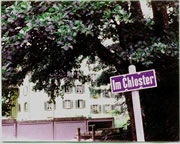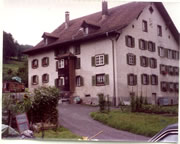|
 |
THE BORSINGER CHRONIK
|
|
|
THE HISTORY OF BORSIKON |
| BIBLIOGRAPHIC LEXICON OF ZUERICH: In 833 a hamlet of the Allamann PORSO, according to a document of the “Fraumuensteramt” later on known as Borsikon went through trade out of the possession of the Benedictine Monastery of Felix and Regula into worldy hands. It is located below the lake of Tuerlen at a spot of the present farmhouse “Im Chloster” see photo. |
 |
 |
| The CHLOSTER was a monastery like community of Benedictine nuns who have lived there up to the time of the Reformation in the house named “Chloster” (see photo) at the left side of the Reppishbrook. At the beginning of the last century the chapel in that house has still been mentioned. |
| |
In 883 BORSINCHOVA in 1124 BORSINCHON. The people of Borsikon enjoyed great esteem and were Milites (Nobles) and it seems that there lived a nightly ministerial family. The knights of Borsikon have been named in several important businesses.
In 8OO AD the land belonged to the Alamannic Frankish Imperium of Karl the Great (Charlemagne) and around 880 to the German emperor of Ludwig (Regia Dukson Alem). In 853 Louis the German, half brother of Charles II, was ruler of the East Frankish kingdom or Germany. He granted all his lands in the “Pagellis Uroniae” (Uri) including the region of the Albis, where Borsikon is located, to the Abbey of Felix and Regula in Zuerich. This Abbey was not subject to the Courts of the surrounding Zuerichgau but protected by a VOGT (Advocate) or special representative of the King. Vogt became hereditary. In 917 the Zuerichgau was ruled by the Dukes of Lenzburg and after l097 by the Dukes of Zaehringen. In l400 by Johann Meier, Mayor of Zuerich. Borsikon remained under the Meiers of Knonau and in l5l2 the entire region was sold to the city of Zuerich.
Between 900-l250 we know very little about the condition of local ownership, the history of Europe in general, however, shows that Charles II was crowned Emperor by Pope John III in 851 and was the last of the Carolingians. Charlemagne’s empire fell in 855. From the 10th to the 12-century the Zaeringer from the Black Forest reigned over Switzerland and upper Burgundia until the death of Berchtold V in l2l8. In l000 Borsikon belonged to the Lord of Waedenswil. In lO32 Union of Burgundian and German crown under Conrad II brought Switzerland into the Holy Roman Empire, French, German and Italian speaking people. In 1185 Borsikon belonged to the Lords of Eschenbach, in the 13 Century it belonged to the Monastery of ST. Blasien, who in 1381 sold it to the Lord of Huenenberg, Adminstrator (Vogt) of the Duc of Schwabenburg. In l4l1 Vogt of Ballwil - Administrator of Duc of Aarburg. After that it was bought by the Meiers of Knonau, which later became Mayors of Zuerich and they sold it under Gerold Meier to the City of Zuerich.
We have now entered a different political time. In the 11 Century the archbishop of Strassbourg sent a relative to build a castle on the Aare River, near present Brugg. The castle was a tower, which looked like a hawk tower (“Habichtsburg”) which gave them the name of HABSBURG. They held Count ship of the Zuerichgau from 1173 as the German kings representatives, also of Uri and Unterwalden, and in l218 Zuerich became an Imperial City and the Zuerichgau, where Borsikon is located, was also acquired by them. In l231 the German King Henry VII of the Hohenstaufen dynasty bought the Vogtei back from the Habsburg in order to have control over the Gotthard pass, but the Habsburg retained the Aargau and the Zuerichgau and its junior line of Laufenburg owned possessions around the lake of Lucerne. In 1273 possessions of the Laufenburg branch was cadet to the senior Alsacean line and soon after, its head became the German king as Rudolf I. |
| |
| From 833, starting with Porso to 1224 with Henricus de Borsinchova there is about 400 years and16 generations of people for which we have no documentation and we always will be left in the dark, we can only assume that they were farmers. |
| |
Not far from Borsikon is Einsiedeln (where I studied Philosophy from 1934 -36) it was founded in 934 by an eremite (in German “Einsiedler”) St.Meinrad who came from the region of Thueringen and studied at the Island of Reichenau at the lake of Constance and then moved into the woods where he built his hermitage and where he was murdered. A big monastery was built and in l274 its Abott was made a Prince of the Holy Roman Empire, protected by the court of Rapperswil and in 1295 under the Laufenburg-Habsburg. In 900 Christianity was well advanced. The Dukes of Lenzburg which were very powerful prior to the Hapsburg have their monumental graves in Beromuenster in a beautiful church and while I may mention it, my brother Fredy who belongs to the “Knights of the Holy Grave” (their Swiss headquarter is in Beromuenster) had our family crest painted on a wall in the cloister (Kreuzgang) of this church with the crest of other members of this order and it will remain there for times to come. The HABSBURG have their graves in the cloister of Koenigsfelden in the beautiful gothic church of the former monastery, at present a psychiatric institution.
I asked myself, what attracted the Borsinger's to Zuerich. During the Roman time, ZUERICH had a Roman castle on the hill, now the Lindenhof, during the Helvetics Zuerich had a custom station there. On the right side of the river there is the Grossmuenster (Cathedral), apparently built under Charlemagne. In l218 Zuerich had become an Imperial City with a royal residency in its Imperial Palace on the hill of the present Lindenhof and the Fraumuenster Abbey and church is on the left of the river. Zuerich had developed as a crossroad between south and north and east and west into a commercial trade center and was known for its silk and later on textile industry. In the beginning of the l3th Century ambitious members of the Borsikon farmers accomplished to become Citizens of Zuerich and there to be knighted. |
| |
According to the BIBLIORAPHIC LEXICON of ZUERICH: The Hamlet Borsikon is no longer in existence, was located below the Tuerler lake at a spot of the present farmhouse “CHLOSTER” in 883 Borsinchova, 1224 Borsinchon l23l a family of Knights has taken its name from the Borsikon and the family is mentioned in Zuerich from 1224-1259.” About the year of l400 John Meier, mayor of Zuerich and his brother Rudolf bought the bailiff of Knonau for l50 Gulden, including Borsikon. The family of the Meiers to Knonau moved soon up to high esteem. Originally they were administrators of the possessions of the monastery of Schaenis which owned land and rights in Aeugst and Knonau. Little by little they knew to change their rights into sovereign rights and heritable fiefs. The reason for that was probably that the founding proprietors (landlords) in Schaenis lived far away. The Meiers, originally the administrators of the Meierhof at Knonau, became citizens of Zuerich in l365. Already in l371 Johann Meier as a noble member was seated at the “Kornstaffel” (apparently wheat administration) in the Great Council, and his son, Johannes became Mayor of Zuerich in1393. In l400 he became the owner, for l50 Gulden, of Borsikon and Aeugst. Out of this time came the “Oeffnung” von Borsikon, which is a community ordinance containing all the regulations about taxes, fiefs, boundaries, pastureland etc. and this document is still in existence. In1415 the Swiss Federation conquered the Aargau. The area between the Reuss River and the Albismountains came to Zuerich. The sovereignty of Knonau with Aeugst, Borsikon etc. remained under the Meiers of Knonau and the supremacy of the city of Zuerich. 1412 The heirs of the family of Junker Gerold Meier sold all the rights, fiefs, legalities and stewardship of the sovereignty of Knonau, this included Aeust, Borsikon and Breitmatt to the City of Zuerich for l650 Gulden in Rhemisch gold.
1450 Pest epidemic.1454 the name Borsinger has disappeared completely in the Aeugst valley. We find the name Borsikon or Borsinger in l450 in the neighboring Rifferswil, Hausen am Albis and Steinhausen. There they still are farmers. A Borsinger is an officer in foreign services under the king of France l493/l500 Captain and commander of the mercenaries in the French Royal Services, and as such condemned by the court on account of “Musterbetruegerei” at the battle of Novarra in Italy (retaining of payments to the soldiers from King Charles III.)
We don’t know the reason for the abandonment of Borsikon which was inhabited for centuries. Did the pest epidemic in l450 had something to do with it? According to tradition it is known that during the time of the Reformation many people have out of “inner Unrast”(restlessness) made changes. May be inhabitants of Borsikon were motivated for the same reason to give up their homesteads, which were located in an isolated area. In l504 only one representative of Borsikon went to Zuerich to the annual “Freischiessen” (riffle shooting match), was he the last homestead owner of the settlement? Anyhow it is quiet questionable if the documents at the archives of the monastery of St. Blasien from the year l550, stating “Strass gan Borsikon” (a road toward Borsikon) mentioned a village or only the “Chloster” at the overpass of the Reppisch. If we assume that the village completely disappeared in the l6th century the name stayed attached for the next 300 years in the memories of inhabitants in the surrounding areas to the “Chloster”. The last mention of the Chloster or “homestead Borsikon” is found in 1816 in the Community Registry and does not exist further on, nor have the present old folks of Aeugst ever heard about the name of this well documented hamlet. |
| |
 |
| |
|
|
|

